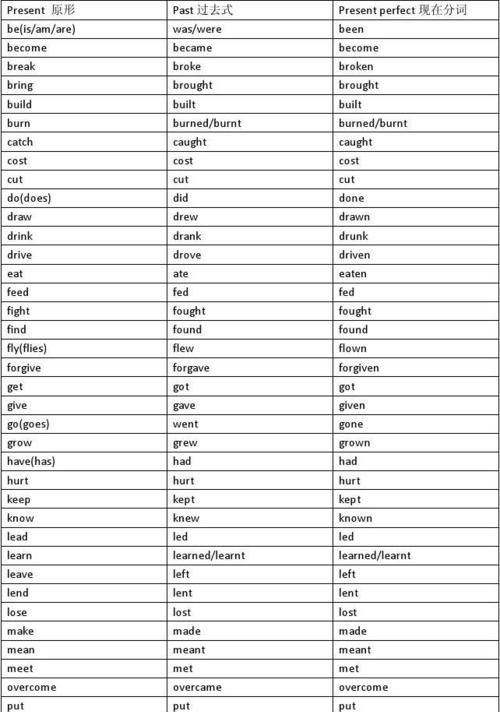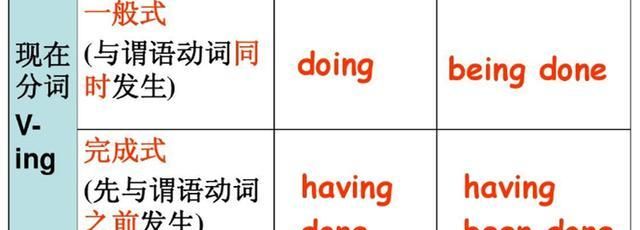本文目录
现在分词怎么变
现在分词是非谓语动词的一种形式,顾名思义非谓语动词是不能作谓语但又具备动词性质和特征的一种动词形式。以do为例,它的基本形式是doing,被动形式是being done,完成是形式是having done,完成时的被动形式是having been done,所有否定式都是not+doing,即not紧跟现在分词形式,例如:not doing/not having done等。现在分词从时间上来讲表示进行,从语态上来讲表示主动,记住分词和它的逻辑主语一定是主谓关系,亦即它的动作就是逻辑主语发出来的。另外,现在分词除了不能做谓语之外,他可以做表语、定语、状语、宾语补语等,它还具备一些动词的特征,比如,它后面可以带宾语,也可有自己的状语等。
下面请看一道例题:1,Thinking of his son,who was killed in a traffic accident,______.
A.his heart sank B.he was in deep sorrow C.tears came into his eyes D.we found him in tears
解析:现在分词作状语时,分词的动作要和主句主语保持一致,也就是说,分词的动作也是主句主语发出来的,是属于逻辑上的主谓关系。分析这一道题,A,C选项的主语都不会thinking of,想起他儿子的只有是he,所以答案选择B.
2, The retired man donated most of his savings to the school damaged by the earthquake in Wenchuan,__________the students to return to their classrooms.
A.enabling B.to enable C.to have enabled D.having enabled
追问:答案选A,但是能不能选B呢,不可以看成是不定式作目的状语吗?另:请再解释一下the school damaged by.....中的damaged的用法?是过去分词作定语吗?为什么它可以省略which was?
解析:你的理解有一定道理,但是你只知其一不知其二,动词不定式做目的状语放在句子的后面常常不能用“,”隔开,所以由于本题中在Wenchuan就出现了一个小小的逗号,故不能选择B而只能选择A了。damaged by...就是过去分词作后置定语,表示被动。过去分词做后指定语时,常常可以改写成which was damaged by引导的定语从句。
现在对于现在分词的用法总结如下:
1,现在分词(短语)作表语
(1) 其实分词分为现在分词和过去分词,做表语的现在分词往往表示“令人怎么样”修饰物,而过去分词往往表示“让人感到怎么样”,描述人;例如,interesting,有趣的,修饰物,an interesting book.一本有趣的书,而interested则是描述人,I am interested in a book.是说我对于书籍感兴趣。另外,exciting令人激动的,而excited则是“感到激动的”,moving是“令人感动的”,而moved则是“受感动的”
如:Traveling is interesting but tiring.
旅行有趣但易疲劳。
The pupils will get confused if they are made to learn too much.
如果学生学的太多,他们会糊涂的。
(2) 分词作表语,相当于形容词,往往表示主语的性质、特征或状态,不能与正在进行时(现在分词)和被动语态(过去分词)混为一谈。它们的形式虽然相同但是意义区别很大。注意:一般进行时和被动语态表示动作。

英语中的现在分词怎么用
你好:为你提供精确解答
你说你的英语语法不太好,那么我就说明白一些。
现在分词在英语中一般表示动作正在进行。而单独的动词,也就是一般现在时是表示动作发生这一事实。
就好比这句,用building表示正在建,翻译为:政府将不断建造新的宾馆。
而如果用build,那么翻译为:政府将建造新的宾馆。
第一句强调将来时态动作的不断持续。一般现在强调将会建造这一事实。
谢谢,不懂可追问~~~

现在分词的用法
1.作主语:通常被看作是单数不可数名词,所以谓语动词用第三人称单数形式。
Driving fast is very dangerous.
Swimming is my favourite sport.
Painting is an art.
Hearing the bad news made him cry.
注意:现在分词作主语时,和动词不定式一样,当它是较长的短语时,常常用it作形式主语,而把现在分词放到句末。
如:It's nice spending the holiday at the beach.
It's tiring working late.
现在分词作主语时的常用句型:
a waste of time
no good/no use
It +be+ little/hardly any use + V-ing分词
not/hardly worth
worth/worthwhile
如:It's no use complaining.
It's no good smoking a lot.
It's a waste of time doing such a thing.
no
no sense in(没有道理)
There +be+ no point in(毫无意义) +V-ing分词
no use in
Nothing worse than(没有比...更糟糕的)
如:There was no knowing what he was doing.
There is no point (in) doing so.这么做,毫无意义。
经常跟在it +be后面的形容词,然后接动名词作实际主语的形容词还有:
Odd古怪的 Crazy疯狂的 Hopeless无望的 Nice
Funny好笑的 Foolish愚蠢的 interesting Tiring累人的
better terrible Enjoyable愉快的 Pointless无意义的
2作表语:-ing分词作表语多和系动词be连用。注意:如果主语用了不定式,表语也要用不定式;同样地,如果主语用的是-ing分词,表语也应用-ing分词。即,作主语和表语的动词在形式上的一致。
如:Seeing is believing=To see is to believe.
My favourite sport is swimming.
Her only hobby(爱好) is collecting stamps.
☆注意:现在分词作表语和动词不定式作表语的区别在于:现在分词表示习惯性动作;而不定式表示一次性的具体动作。
如:My plan is to finish my homework before tomorrow.
My favourite sport is swimming.
3. 作宾语
英语中,有相当一部分动词后,只能接-ing分词作宾语。
这类动词主要有:
Admit承认 advise Anticipate期望做。。 Detest憎恨做。。。
Defer推迟 suggest Escape逃避做。。 Quit停止做。。
Deny否认 Miss错过 Avoid避免做。。。 Tolerate忍受。。
Keep保持做。。。 Appreciate感谢。。。 Practise练习。。 enjoy
Mind介意 Consider考虑做 Risk冒险做。。。 Excuse原谅
如:
Excuse me interrupting you.
I enjoy reading newspapers.
I suggest you should practise speaking English every morning.
注意:有一类动词后即可跟不定式作宾语,也可跟-ing分词作宾语。可以把这类动词分为三种类型:1)两种形式意义基本相同。2)两种形式略有差别。3)意义完全不同。
A)两种形式意义基本相同的动词有:attempt, begin, cease(停止), continue, intend, start, commence(开始).
如:She started to cry/crying.
What do you intend to do/doing next?你打算接下来做什么?
He continued to work/working.
B)两种形式意义略有差别的动词主要有:hate, like, dislike, love, prefer等。
如:I like playing basketball.
I hate to trouble you.
I prefer to go for a walk.
I prefer singing songs.
C)后跟不定式和-ing分词时,意义完全不同的动词有:remember, forget, regret., try, mean, chance(碰巧),cannot help...等。它们后面跟不定式表示动作还未发生,而跟现在分词表示动作已经发生。
如:I regret to do this thing.
I regret doing such a thing.
Mean to do 表示打算,意欲做某事:而mean doing表示“意味着,意思是”
如:I mean/plan to buy a house.
Fighting means killing.
Chance to do表示碰巧做某事;而chance doing表示冒险做某事、碰运气试着做某事
He chanced to meet his old friend in the street.
He chanced taking part in that race.
Cannot help to do表示不能帮忙做某事;Cannot help doing表示情不自禁,不由得做某事
如:I cannot help to do homework for you.
I cannot help laughing.
4. 作介词宾语
除了我们已经谈到的“疑问词+不定式”可以作介词宾语外。通常情况下,只能用-ing分词作介词的宾语。但个别表示“除了。。。之外”的介词如“except, but, than”通常接不定式。
如:I can do nothing except/but wait.
后面跟-ing分词作介词宾语的短语结构主要有:
A)“动词+介词+动名词”
I am used to sleeping on the floor.(习惯于。。。)
I am looking forward to meeting you.
The rain stopped us from working.
She objected to marrying him(反对)
B)“形容词+介词+-ing分词”
I am interested in playing basketball.
Tom is responsible for breaking the glass.
C)"名词+介词+动名词"
There are many ways to do it/of doing it.
He didn't go out for fear of raining.
-ing分词的惯用搭配有:
A)主语+have+fun/pleasure/a good time/trouble/difficulty+(in) doing sth
如:We had a lot of fun (in) playing basketball.
I have trouble/difficulty(in) understanding him.
B)“There is+difficulty/trouble/pleasure+(in) doing sth”
如:There is difficulty in passing the exam.
There is trouble in learning a foreigh language.
C)“be busy+(in) doing sth”
I am busy in doing my homework.
D) “What about/How about +-ing分词”(征求意见句型。。。怎么样)
What/How about having a cup of tea?
How about playing basketball with me?
E)注意:有一类-ing分词和go搭配,表示“去(干。。。)”,这些分词大多与休闲娱乐的户外活动有关。
常用的有:
boating Camping野营 Climbing爬山
Driving驾车兜风 Dancing跳舞 Hiking徒步旅行
Hunting打猎 Fishing垂钓 running
Jogging慢跑 Ridding骑马 Sailing航行
Shopping购物 Sightseeing观光 Skating滑冰
swimming Walking散步 Window shopping逛街
如:We went boating yesterday.
5.作定语
单个分词作定语时放在所修饰名词前
a running boy
the girl standing there (分词短语作定语,故置于所修饰名词之后)
并且一般都可以转化为一个进行时的定语从句
如: a boy who is running
a girl who is standing there
注意:某些现在分词作定语时,已不再表示动作,已经从分词变为了形容词词性。如:an interesting story, an exciting match 。这些也可以属于现在分词作定语,但是不能转化为相应的定语从句。但是可以有三级变化(原级、比较级、 最高级)和被某些副词如very修饰。
6.作宾语补语
只有两类动词可以加现在分词作宾补
1)感官动词或心理状态的动词:see,hear,watch,feel,notice,observe,find,listen to,look at
2)表示致使意义的动词:make, have,get,catch,leave,keep, let
注意:但是并不代表这些动词后的宾补形式都要用现在分词(有些后面可以加不带to的不定式作宾补)
eg.I saw him singing now.
和 I saw him sing in the house.
注意 :宾语与作宾补的现在分词之间存在逻辑上的主谓关系,即宾语是现在分词动作的发出者。
7.作状语
分词作状语时的逻辑主语(即分词动作的发出者)一般要与句中主语保持一致。若逻辑主语和分词动作之间为主动,用主动。反之,用被动。
A)作时间状语
如:.Walking in the street,I saw him.当我在街上走时,我看到他了
可以转化为一个时间状语从句:When/While I was walking in the street,I saw him.
注意:当我要强调正在进行的动作时 我们可以在分词前面加上when/while 那么上面的例句就可以改写为When/While walking in the street,I saw him.(其实这是省略了从句中的I was,因为从句的主语和主句一致)。
如果句子为:
When/While he was walking in the street,I saw him. 当他走在街上,我看到他了。
这里,由于从句主语和主句主语不一致,故不可省略。
B)作条件状语
如: Working hard,you will succeed. (只要)努力工作,你就会成功。
可以转换为if引导的状语从句。即:If you work hard, you will succeed.
C)作原因状语
如: Being ill,she stayed at home. (因为)生病,她留在家里
注意 being是常用来作原因状语的
这句可以转换为相应的原因状语从句:Because/As she was ill, she stayed at home.
D)作让步状语
如. Having failed many times,he didn't lose heart. 有很多次失败,他没有灰心。
=Although he had failed many times, he didn't lose heart.
E)作结果状语
如: His friend died,leaving Tom a lot of money, 他的朋友死了,(所以)给汤姆留了很多钱。
=His friend died, so he left Tom a lot of money.
F)作方式状语
如:Please answer the question using another way. 请用另一种方式回答这个问题
G)作伴随状语,表示现在分词的动作正在进行中。
如:
He sat on the chair, singing songs.
They left the shop, satisfied.
The worked for a whole day, exhausted.
They watching TV in the living room, I was cooking in the kitchen.
8. 现在分词的独立主格
(1)独立主格,又叫独立结构,在句中作状语。它没有主语和谓语,只有逻辑上的主语,因此,它在句法上不是句子,而是一个独立于句子成分之外的独特结构形式。
(2)独立主格结构可置于句首、句尾,用逗号与主句隔开。 独立主格结构可分为两部分,一部分是名词或代词(主格),起着逻辑主语的作用;另一部分由形容词、副词、名词、分词、不定式、介词短语等构成,表示前面名词或代词的状态、状况或动作。
如:He entered the room, his nose red with cold.(名词/代词+形容词)
He lay on his back, his hands behind his head.(名词/代词+介词短语)
He entered the classroom, a book in his hand.
He lay on the bed, his eyes closed.
A good student, he always studies very hard.
Whatever the reason, Bob went aboard finally.
(3)这和我们学过的”with的复合结构”是差不多的,只不过它要比独立主格多个with.
(4)分词作状语时,其逻辑主语一般要与句中主语保持一致”不难发现我每次在叙述这句话时都加上”一般”二字 那也就是说也有特殊的时候 就是分词的逻辑主语不和句中主语保持一致 也就是拥有了自己的独自的逻辑主语 那么也就是该用独立主格的时候了.
如:Winter coming,it gets colder and colder.冬天来了 天变的越来越冷了
注意这句话,我们不难发现it在句中指代的是”天气” 。那么当我把winter去掉的时候,那在形式上就是纯粹的分词作状语。那么我们也就是默认了coming的动作是由it(天气)发出来的。但是我们不妨翻译一下”当天气来的时候,天气变的越来越冷了.”显然句意不通。那么就是说coming的逻辑主语不是it(天气),也就是coming拥有自己的逻辑主语。那么也就是winter,因为coming的动作是由winter发出的。

英语现在分词的用法详解
一、现在分词的两个基本特点.
1.在时间上表示动作正在进行.例如:a developing country.一个发展中的国家,boiling water 沸水,rising sun 冉冉升起的太阳.(试比较:a developed country 一个发达国家,boiled water 白开水,risen sun 升起的太阳)
2.在语态上表示主动.例如:the ruling class 统治阶级,the exploiting class 剥削阶级.(试比较:the ruled class 被统治阶级,the exploited class 被剥削阶级)
二、掌握现在分词的基本功能.
1.现在分词作定语,表示正在进行的或主动的动作.也可以说明被修饰词的性质和特征,此时可换成相应的定语从句.例如:
① There was a terrible noise ___________ the sudden burst of light.(MET 1989)
A.followed B.following
C.to be followed D.being followed
分析:B .表示主动的动作,句意是:雷声跟着闪电.此处的 following = which followed .
② He saw a ________ bird and raised his bow.
A.fly B.flying
C.flew D.to be flying
分析:B .表示正在进行的动作,句意是:正在飞的鸟.此处的 a flying bird = a bird which was flying .
③ I was satisfied with the _________ speech.
A.excite B.exciting
C.excited D.be excited
分析:B .表示被修饰词 speech 的性质和特征,此处的 the exciting speech = the speech that/which was exciting .
2.现在分词作状语时,可作时间、条件、结果、原因和伴随状语,表示正在进行的或主动的动作.此时分词的逻辑主语就是主句的主语,因此要注意人称、时态和语态的一致性.例如:
① The visiting minister expressed his satisfaction with the talks,____________ that he had enjoyed his stay here.(NMET 1994)
A.having added B.to add
C.adding D.added
分析:C .句意:来访的大臣表示了对谈判的满意,同时又补充说道他呆在这里很愉快.adding 作伴随状语,表示主动的动作.所以应用现在分词作伴随状语.
② European football is played in more than 80 countries,__________ it the most popular sport in the world.(NMET 1998)
A.making B.makes
C.made D.to make
分析:A .句意:欧式足球在 80 多个国家开展,其结果是它使欧式足球成为世界上最受欢迎的体育运动.making 是现在分词作结果状语.
③ ________ from the top of the hill,we can find that the city looks more beautiful.
A.Seeing B.Seen
C.Saw D.To be seeing
分析:A .Seeing 是逻辑主语就是主句的主语 we ,表示正在进行的主动动作.
3.现在分词作补足语,表示正在进行的或主动的动作.例如:
① Soon they could see the steam _________ from the wet clothes.
A.rise B.rising

以上就是关于英语中的现在分词怎么用,现在分词怎么变的全部内容,以及英语中的现在分词怎么用 的相关内容,希望能够帮到您。
